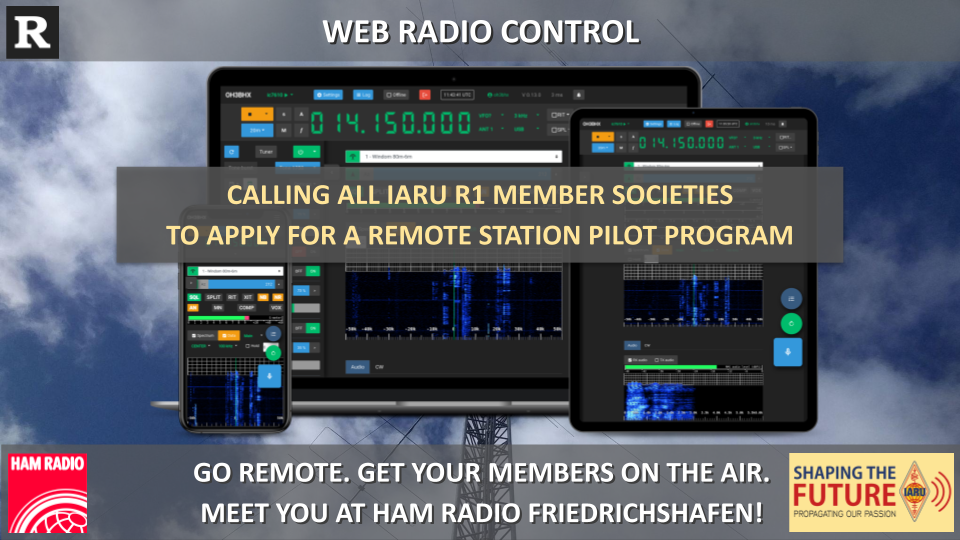Web Radio Control invites all IARU R1 member societies to apply for a pilot program that will enable web-based remote operation on existing amateur radio stations. The goal of the program is to have national amateur radio associations offer remote stations as a benefit for their members! Operators will have access to the full set of Web Radio Control features: they may book the station for exclusive access, and they need only a device with a web browser to operate the station. The feature tour video gives a quick overview on how you can use Web Radio Control for remote operation.
Please see the end of this post for details on applying to the pilot program!
IARU Region 1 has accepted building of remote amateur radio stations based on Web Radio Control as one of the projects in the Shaping the Future initiative! The project will be supported by IARU Region 1 and the first pilot stations will be set up in the second half of 2023. Web Radio Control is proud to be a part of this initiative and to be able to support the future of amateur radio!
Web Radio Control developer Mikael Nousiainen OH3BHX will be present at the IARU Open Innovation Zone booth A1-864 at Ham Radio Friedrichshafen on June 23rd and 24th, and will be happy to discuss the details of the project and to receive applications for the pilot program.
Why remote stations?
Remote stations benefit both the national associations and their members! For the national associations, they are a solution to get new members and to keep existing members active. For the members, they provide an easy way to get on the air, even if they don’t have a station of their own.
There are many challenges in setting up an amateur radio station. For example, there may be no good locations for installing antennas or antennas may be prohibited. In urban environments, excessive RF noise may prevent operating altogether. Moreover, setting up a station may be too expensive and complicated for many operators, especially for beginners.
Simply put, many radio amateurs lack access to this core part of amateur radio.
Remote stations are a solution to these challenges. They make it easy for beginners to get started with operating on the bands. They enable operating from locations where it would otherwise be impossible, and they provide a way to get on the air quickly and easily. Remote stations also allow operators to try out new modes and bands, and to get on the air even when travelling.
Pilot program details
The pilot program will include setting up 3 remote stations in different national associations in the second half of 2023. After gathering experiences from the pilot, the project to provide remote stations among IARU R1 member societies will expand further! The goal is to have at least 10 more stations in operation by the end of 2024.
The pilot program stations will be set up in collaboration with Web Radio Control, the national association and the station owner. Web Radio Control will provide technical support for installing and maintaining the stations, and the national association will be responsible for the station hardware, including Internet connectivity and the Raspberry Pi hardware running the software. IARU Region 1 will cover the cost of the software and related technical support.
Applying for the pilot program
To apply for the pilot program, please send an email to Web Radio Control developer
Mikael OH3BHX: mikael (at) webradiocontrol.tech.
The application should include:
-
A brief description of the station hardware (rigs, rotators, antenna switches, etc.)
-
Station location
-
The quality of the Internet connection
-
Note that a public IP address with the ability to set up web servers is required (can be either a dynamic or a static IP address)
-
-
Information whether you have a Raspberry Pi (model 2B/3B/3B+/4B) available to run the Web Radio Control software
-
Note that the pilot program will target stations that will run Web Radio Control on a Raspberry Pi. It is possible to run Web Radio Control on other hardware later, but this will not be supported in the pilot program.
-
Stations that have low RF noise level and a transceiver with an integrated USB interface for CAT control are preferred for the pilot.
Please see Web Radio Control hardware requirements documentation for more details on what is required to set up a remote station using Web Radio Control.
Mikael OH3BHX will also be present at the IARU Open Innovation Zone booth A1-864 at Ham Radio Friedrichshafen on June 23rd and 24th 2023, and will be happy to receive applications for the pilot program and to discuss the details of setting up a remote station.
Meet you at Ham Radio Friedrichshafen!
Follow @WebRadioCtrl in Twitter for more updates.
